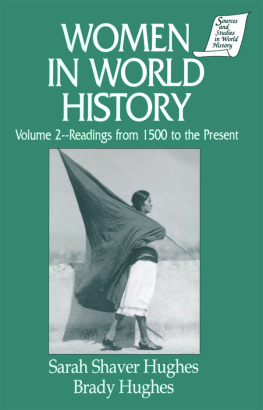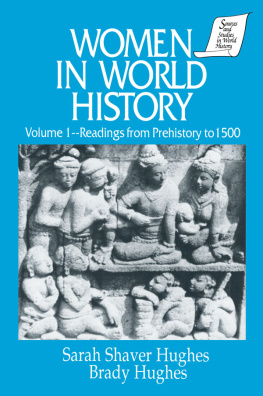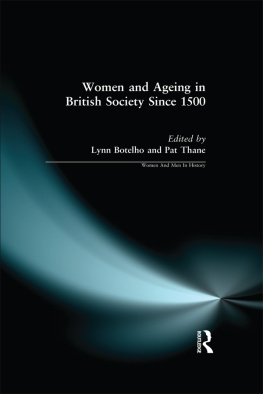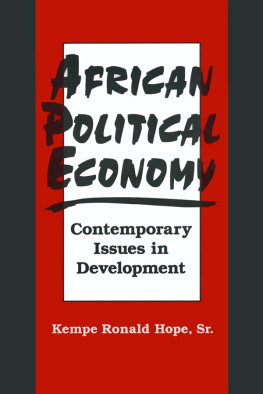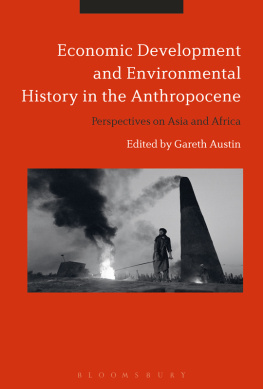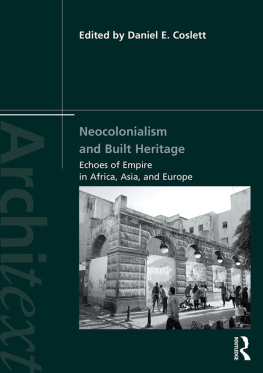WOMEN
IN WORLD
HISTORY
Volume 2
Readings from 1500 to the Present
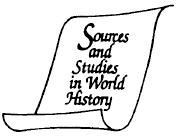
Kevin Reilly, Series Editor
THE ALCHEMY OF HAPPINESS
Abu Hamid Muhammad al-Ghazzali
Translated by Claud Field, revised and annotated by Elton L. Daniel
LIFELINES FROM OUR PAST
A New World History
L S. Stavrianos
NATIVE AMERICANS BEFORE 1492
The Moundbuildittg Centers of the Eastern Woodlands
Lynda Norene Shaffer
GERMS, SEEDS, AND ANIMALS
Studies in Ecological History
Alfred W. Crosby
BALKAN WORLDS
The First and Last Europe
Traian Stoianovich
AN ATLAS AND SURVEY OF SOUTH ASIAN HISTORY
Karl J. Schmidt
THE GOGO
History, Customs, and Traditions Mathias E. Mnyampala
Translated, introduced, and edited by Gregory H. Maddox
WOMEN IN WORLD HISTORY:
Volume 1Readings from Prehistory to 1500
Volume 2Readings from 1500 to the Present
Sarah Shaver Hughes and Brady Hughes
MARITIME SOUTHEAST ASIA TO 1500
Lynda Norene Shaffer
THE COURSE OF HUMAN HISTORY
Economic Growth, Social Process, and Civilization
Johan Goudsblom, Eric Jones, and Stephen Mennell
ON WORLD HISTORY
Johann Gottfried Herder An Anthology
Edited by Hans Adler and Ernest A. Menze Translated by Ernest A. Menze with Michael Palma
TEACHING WORLD HISTORY
A Resource Book
Edited by Heidi Roupp
THE WORLD AND A VERY SMALL PLACE IN AFRICA
Donald R. Wright
DOUBLE GHOSTS
Oceanian Voyagers on Euroamerican Ships
David A. Chappell
TRADITION AND DIVERSITY
Christianity in a World Context to 1500
Karen Louise Jolly
SHAPING WORLD HISTORY
Breakthroughs in Ecology, Technology, Science, and Politics
Mary Kilbourne Matossian
First published 1997 by M.E. Sharpe
Published 2015 by Routledge
2 Park Square, Milton Park, Abingdon, Oxon OX14 4RN
711 Third Avenue, New York, NY 10017, USA
Routledge is an imprint of the Taylor & Francis Group, an informa business
Copyright 1997 Taylor & Francis. All rights reserved.
No part of this book may be reprinted or reproduced or utilised in any form or by any electronic, mechanical, or other means, now known or hereafter invented, including photocopying and recording, or in any information storage or retrieval system, without permission in writing from the publishers.
Notices
No responsibility is assumed by the publisher for any injury and/or damage to persons or property as a matter of products liability, negligence or otherwise, or from any use of operation of any methods, products, instructions or ideas contained in the material herein.
Practitioners and researchers must always rely on their own experience and knowledge in evaluating and using any information, methods, compounds, or experiments described herein. In using such information or methods they should be mindful of their own safety and the safety of others, including parties for whom they have a professional responsibility.
Product or corporate names may be trademarks or registered trademarks, and are used only for identification and explanation without intent to infringe.
Library of Congress Cataloging-in-Publication Data
Hughes, Sarah S.
Women in world history / Sarah Shaver Hughes and Brady Hughes,
v. cm.(Sources and studies in world history)
Includes bibliographical references.
Contents: v. 1. Readings from prehistory to 1500.
v. 2. Readings from 1500 to the present.
ISBN 1-56324-310-5.ISBN 1-56324-31 1-3 (pbk.) (v. 1)
ISBN 1-56324-312-1.ISBN 1-56324-313-X (pbk.) (v. 2)
1. WomenHistory. I. Hughes, Brady, 1933
II. Title. III. Series.
HQ1121.H93 1995
305.409dc 20 94-23644
CIP
ISBN 13: 9781563243134 (pbk)
ISBN 13: 9781563243127 (hbk)
CONTENTS
Neither world history nor womens history was widely taught a generation ago. Proponents of womens history had to fight the widespread assumption that conventional histories of man or mankind were universal, that they spoke for the lives of women as well as men. A major problem with such histories was that the preponderance of sources used were written by men. Despite the insistence that man stood for women as well as men, students were often left with the distinct impression that history was made by men.
In the last twenty years, scholars of womens history have shown that there were many more important women, more sources written by women, and more sources about women than had previously been assumed. A first stage of scholarship in womens history called for the inclusion of women writers, artists, thinkers, rulers, and public figures.
The recovery of important women, largely from elite families, was a valuable correction. But histories that only added women were still centered on what came to be seen as mens topics: war, diplomacy, statecraft, and industry.
Increasingly, historians became conscious of the degree to which past societies had been divided along sexual lines, expecting different work and preparing different lives for men and women. In this second stage of scholarship, it became obvious that the historical experiences of men and women were different. There was no way that the lives of men could represent those of women. The prior historical division of mens and womens lives had defined the male role as public and political, concerned with city, state, war, and foreign relations. History had been written largely by and for men as a way of understanding and celebrating those male activities.
The second stage of scholarship in womens history has challenged this idea of history. A generation of studies has taught us to see the ways in which men and women are socially and culturally conditioned to certain kinds of behavior. This is why scholars speak now about gender, the social and cultural behavior that may build upon or ignore biological sexual identity. To see gender in history is to see the ways in which men and women are trained in different (and similar) activities, to explore those diverse realms, and to understand the dynamic of gender interaction. In plain words, this means not just adding a queen for a day but studying kinship as well as kingship, the family as well as the state, domestic relations as well as foreign relations. Activities in which women have played more important roles than menchildrearing, planting, clothing production, local marketing, health care, educationand those, like art and religion, in which womens role has been as great as mens, are as important a part of the human past as the largely male-dominated outside activities of traditional history books.
Thus, the new historians of women have opened up vast realms of human activity that were largely ignored in past histories because men did not deem them important. And since mens records of the past are more numerous than womens, they have shown us how to read between the lines of those documents, to find new sources in myths, oral traditions, art and artifactin short, to develop new methods of investigation and analysis.
It is remarkable that scholars of womens history and allied scholars of what has come to be known as the new social history (the study of everyday life, average and marginal people, daydreams, diets, dreads, diseases, hopes, and haircuts) have opened up the past at the same time that world history as a field of study has become established. The field of history has exploded both within and beyond traditional boundaries.

